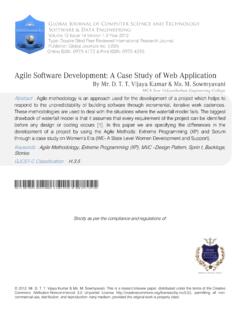Transcription of Scaling Agile @ Spotify
1 Scaling Agile @ Spotify with Tribes, Squads, Chapters & Guilds Henrik Kniberg & Anders Ivarsson Oct 2012. Dealing with multiple teams in a product development organization is always a challenge! One of the most impressive examples we've seen so far is Spotify , which has kept an Agile mindset despite having scaled to over 30 teams across 3 cities. Spotify is a fascinating company that is transforming the music industry. The company has only existed 6. years and already has over 15 million active users and over 4 million paying. The product itself can be likened to a magical music player in which you can instantly find and play every song in the world . Alistair Cockburn (one of the founding fathers of Agile software development) visited Spotify and said Nice.
2 I've been looking for someone to implement this matrix format since 1992 :) so it is really welcome to see.. So how is this managed? We have both presented at conferences and been caught in engaging discussions around how we work at Spotify and how the company handles Agile with hundreds of developers. Many people are fascinated by this, so we decided to write an article about it. Disclaimer: We didn't invent this model. Spotify is (like any good Agile company) evolving fast. This article is only a snapshot of our current way of working - a journey in progress, not a journey completed. By the time you read this, things have already changed. 1/14. Squads The basic unit of development at Spotify is the Squad. A Squad is similar to a Scrum team, and is designed to feel like a mini- startup.
3 They sit together, and they have all the skills and tools needed to design, develop, test, and release to production. They are a self- organizing team and decide their own way of working some use Scrum sprints, some use Kanban, some use a mix of these approaches. Each squad has a long- term mission such as building and improving the Android client, creating the Spotify radio experience, Scaling the backend systems, or providing payment solutions. The picture below illustrates how different squads take responsibility for different parts of the user experience. Squads are encouraged to apply Lean Startup principles such as MVP (minimum viable product) and validated learning. MVP means releasing early and often, and validated learning means using metrics and A/B testing to find out what really works and what doesn't.
4 This is summarized in the slogan Think it, build it, ship it, tweak it . 2/14. Because each squad sticks with one mission and one part of the product for a long time, they can really become experts in that area - for example what it means to build an awesome radio experience. Most squads have an awesome workspace including a desk area, a lounge area, and a personal "huddle". room. Almost all walls are whiteboards. We've never seen a better collaboration space! yes, that's a shark flying around. perfectly normal. To promote learning and innovation, each squad is encouraged to spend roughly 10% of their time on hack days . During hack days people do whatever they want, typically trying out new ideas and sharing with their buddies. Some teams do 1 hack day every second week, others save up for a whole hack week.
5 Hack days are not only fun, they are also a great way to stay up- to- date with new tools and techniques and sometimes lead to important product innovations! A squad doesn't have a formally appointed squad leader, but it does have a product owner. The product 3/14. owner is responsible for prioritizing the work to be done by the team, but is not involved with how they do their work. The product owners of different squads collaborate with each other to maintain a high- level roadmap document that shows where Spotify as a whole is heading, and each product owner is responsible for maintaining a matching product backlog for their squad. A squad also has access to an Agile coach, who helps them evolve and improve their way of working. The coaches run retrospectives, sprint planning meetings, do 1- on- 1 coaching, etc.
6 Ideally each squad is fully autonomous with direct contact with their stakeholders, and no blocking dependencies to other squads. Basically a mini- startup. With over 30 teams, that is a challenge! We have come a long way, but there are still plenty of improvements to be made. To aid in this, we run a quarterly survey with each squad. This helps focus our improvement efforts and find out what kind of organizational support is needed. Here's a visual summary of one such survey, showing 5. squads within a tribe: The circles show the current state, arrows show the trend. For example we can see a pattern where three squads reports problems around releasing and that it does not seem to improve - this area needs urgent focus! We also see that squad 4 does not have a great situation with Agile coach support, but that it is already improving.
7 Product owner - The squad has a dedicated product owner that prioritizes the work and takes both business value and tech aspects into consideration. Agile coach - The squad has an Agile coach that helps them identify impediments and coaches them to continuously improve their process. Influencing work - Each squad member can influence his/her work, be an active part in planning and choose which tasks to work on. Every squad member can spend 10% of his/her time on hack days. Easy to release - The squad can (and does!) get stuff live with minimal hassle and sync. Process that fits the team - The squad feels ownership of their process and continuously improves it. Mission - The squad has a mission that everyone knows and cares about, and stories on the backlog are related to the mission.
8 Organizational support - The squad knows where to turn to for problem solving support, for technical issues as well as soft issues. 4/14. Tribes A tribe is a collection of squads that work in related areas such as the music player, or backend infrastructure. The tribe can be seen as the incubator for the squad mini- startups. , and have a fair degree of freedom and autonomy. Each tribe has a tribe lead who is responsible for providing the best possible habitat for the squads within that tribe. The squads in a tribe are all physically in the same office, normally right next to each other, and the lounge areas nearby promote collaboration between the squads. Tribes are sized based on the concept of the Dunbar number , which says that most people cannot maintain a social relationship with more than 100 people or so (the number is actually larger for groups that are under intense survival pressure, which isn't really the case at Spotify , believe it or ).
9 When groups get too big, we start seeing more things like restrictive rules, bureaucracy, politics, extra layers of management, and other waste. So tribes are designed to be smaller than 100 people or so. 5/14. Tribes hold gatherings on a regular basis, an informal get- together where they show the rest of the tribe (or whoever shows up) what they are working on, what they have delivered and what others can learn from what they are currently doing. This includes live demos of working software, new tools and techniques, cool hack- day projects, etc. Squad dependencies With multiple squads there will always be dependencies. Dependencies are not necessarily bad - squads sometimes need to work together to build something truly awesome. Nevertheless, our goal is to have squads be as autonomous as possible, especially minimizing dependencies that are blocking or slowing a squad down.
10 To aid in this, we regularly ask all our squads which other squads they depend on, and to what extent those dependencies are blocking or slowing the squad down. Here's an example: Text We then discuss ways to eliminate the problematic dependencies, especially blocking and cross- tribe dependencies. This often leads to reprioritization, reorganization, architectural changes or technical solutions. 6/14. The survey also helps us see patterns around how squads depend on each other - for example that more and more squads seems to be slowed down by operations. We use a simple graph to track how the various types of dependencies increase or decrease over time. Scrum has a practice called scrum of scrums , a synchronization meeting where one person from each team meets to discuss dependencies.











